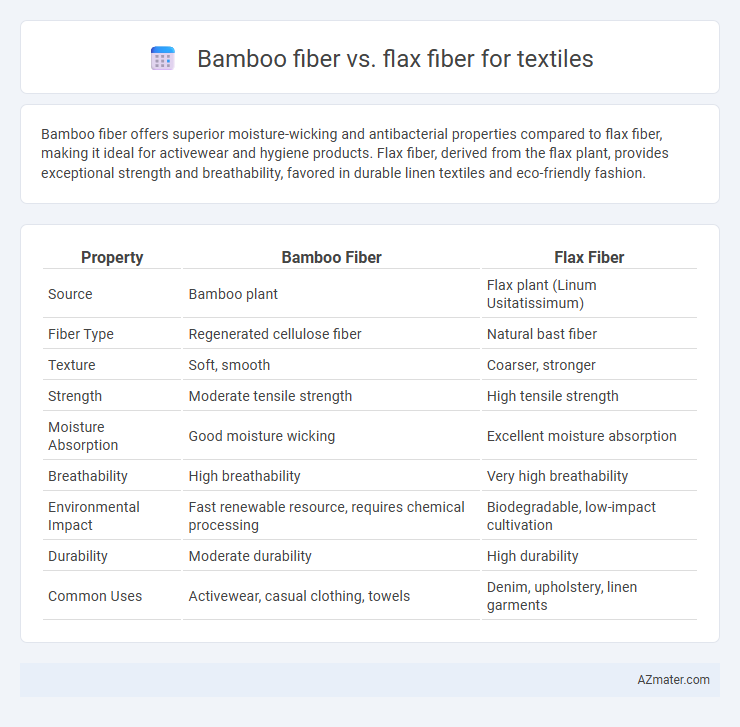Bamboo fiber offers superior moisture-wicking and antibacterial properties compared to flax fiber, making it ideal for activewear and hygiene products. Flax fiber, derived from the flax plant, provides exceptional strength and breathability, favored in durable linen textiles and eco-friendly fashion.
Table of Comparison
| Property | Bamboo Fiber | Flax Fiber |
|---|---|---|
| Source | Bamboo plant | Flax plant (Linum Usitatissimum) |
| Fiber Type | Regenerated cellulose fiber | Natural bast fiber |
| Texture | Soft, smooth | Coarser, stronger |
| Strength | Moderate tensile strength | High tensile strength |
| Moisture Absorption | Good moisture wicking | Excellent moisture absorption |
| Breathability | High breathability | Very high breathability |
| Environmental Impact | Fast renewable resource, requires chemical processing | Biodegradable, low-impact cultivation |
| Durability | Moderate durability | High durability |
| Common Uses | Activewear, casual clothing, towels | Denim, upholstery, linen garments |
Introduction to Bamboo and Flax Fibers
Bamboo fiber, derived from the fast-growing bamboo plant, is prized for its natural antibacterial properties, high moisture-wicking ability, and eco-friendly cultivation. Flax fiber, sourced from the flax plant, is celebrated for its strength, breathability, and linen-like texture, making it a staple in sustainable textile production. Both fibers offer biodegradable alternatives to synthetic textiles, with bamboo excelling in softness and antibacterial features, while flax provides superior durability and a distinctive natural feel.
Origins and Sources of Bamboo and Flax
Bamboo fiber is derived from the pulp of bamboo plants, primarily sourced from fast-growing species found in Asia, particularly China and Southeast Asia, which allows for sustainable and rapid harvest cycles. Flax fiber originates from the flax plant, predominantly cultivated in Europe, Canada, and parts of Asia, where it has been traditionally grown for over 6,000 years as a natural source for linen production. The contrasting botanical sources influence their textile properties, with bamboo offering moisture-wicking benefits and flax contributing exceptional strength and breathability to fabrics.
Fiber Structure and Surface Characteristics
Bamboo fiber features a smooth, round structure with a natural sheen, promoting softness and moisture-wicking properties ideal for textile applications. Flax fiber, derived from the flax plant, exhibits a more irregular, polygonal cross-section with a rougher surface, enhancing breathability and durability in fabrics. The distinct surface morphology of bamboo fibers allows for better dye absorption, while flax fibers provide superior tensile strength due to their lignin and cellulose composition.
Environmental Impact and Sustainability
Bamboo fiber production requires less water and pesticides compared to traditional cotton, but the chemical-intensive process used to transform bamboo into viscose fiber raises environmental concerns. Flax fiber, derived from the flax plant, boasts a low environmental footprint due to minimal water use, biodegradability, and the ability to grow in poor soils without synthetic fertilizers. Sustainable textile choices favor flax fiber for its natural processing and regenerative agricultural benefits, while bamboo's sustainability depends heavily on the extraction methods employed.
Mechanical Properties: Strength and Durability
Bamboo fiber exhibits high tensile strength and excellent flexibility, making it highly resistant to wear and tear compared to many natural fibers. Flax fiber, known for its superior stiffness and durability, offers remarkable tensile strength and resistance to abrasion, often used in high-performance textile applications. Both fibers contribute to sustainable textiles, but flax fibers generally provide enhanced mechanical robustness, while bamboo fibers excel in elasticity and comfort.
Comfort and Breathability in Textiles
Bamboo fiber offers superior moisture-wicking properties and natural antibacterial qualities, enhancing comfort and breathability in textiles. Flax fiber, derived from flax plants, provides excellent thermal regulation and durability, ensuring coolness and comfort in warm conditions. Both fibers contribute to breathable fabrics, but bamboo excels in softness and moisture management, while flax delivers strength and temperature control.
Moisture Absorption and Wicking Abilities
Bamboo fiber exhibits superior moisture absorption and wicking abilities compared to flax fiber, making it highly effective for managing sweat and maintaining dryness in textiles. Bamboo fibers have microporous structures that enhance breathability and enable rapid moisture transfer away from the skin. Flax fiber, while breathable, absorbs moisture at a slower rate and holds it longer, which can reduce comfort during high perspiration activities.
Processing Methods: From Plant to Fabric
Bamboo fiber is typically processed through mechanical crushing and enzymatic retting or chemical methods like viscose production to extract soft, breathable textile fibers, while flax fiber undergoes traditional retting, breaking, scutching, and hackling to separate and align the long bast fibers for linen fabric. Mechanical and chemical processes for bamboo can vary in environmental impact, with mechanical methods preserving fiber strength and sustainability, unlike some chemical treatments. Flax fiber processing relies heavily on moisture, microbial activity, and manual refinement to produce durable, coarse linen favored in high-quality textiles.
Applications in Textile Industry
Bamboo fiber offers excellent moisture-wicking and antibacterial properties, making it ideal for activewear, underwear, and home textiles such as towels and bed linens. Flax fiber, derived from the flax plant, is renowned for its strength, breathability, and durability, frequently used in high-quality linen fabrics, upholstery, and summer apparel. Both fibers support sustainable textile production but serve distinct applications: bamboo excels in soft, comfortable garments, while flax is preferred for structured, breathable, and long-lasting textiles.
Cost, Availability, and Market Trends
Bamboo fiber offers a cost-effective alternative to flax fiber due to its rapid growth rate and higher yield per acre, making it more readily available in global textile markets. While flax fiber, known for its durability and natural luster, commands a premium price, its cultivation is limited by climate and seasonality, impacting consistent supply. Current market trends indicate rising demand for sustainable bamboo textiles driven by eco-conscious consumers, whereas flax retains niche appeal in luxury and high-performance fabrics.

Infographic: Bamboo fiber vs Flax fiber for Textile
 azmater.com
azmater.com